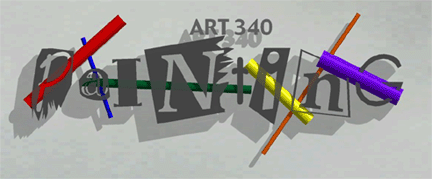SECOND SEMESTER PROJECTS
Painting 1: Planes Dictate Shape.
Using a 9" x 12" canvas panel as your support and ground, paint the still life without drawing the set up. Focus only on the planes. This assignment is intended to foster more immediate responses to the still life. Even though the shapes may change, paint this work without drawing any shapes in advance. Instead think of the shape of particular planes.
Assignment 1: Monochrome Value Scales.
Using a 9" x 12" canvas panel, paint a 7-step monochromatic value scale in Ultramarine blue, cadmium red, and cadmium yellow. Black and white will be two of the values in each set.
Painting 2: Flat Space Still Life.
Using a 9" x 12" canvas panel as your support and ground, paint a simple still life with no variation in value. Use a variety of colors, but always keep the value the same. Deny volume without sacrificing the image.
Paper 1: Ancient Techniques.
Write a three-page paper about an ancient process and images produced by these techniques. The paper should have a minimum 3 sources and be accompanied by some images of artwork. Add a cover page and bibliography. Citations from sources should be included.
Painting 3: Ancient Techniques and the Figure.
Choose either egg tempera, encaustic, or fresco and execute a painting (9" x 12" or larger) which incorporates the figure in some way. Self portraiture is acceptable. This painting will include preparation of grounds, as well as painting.
Assignment 2: Building Stretcher Frames.
Build two 18" x 24" stretcher frames and stretch canvas. This process will be explained in detail, demonstrated and much of the work will be done outside of the painting room. The resulting canvases will be used in Painting 4 and 5.
Painting 4: Figure and Myth in Glazes.
This work will be executed on an 18" x 24" stretched canvas. There will be a model available. The intention here is to create a painting that implies myth or draws from mythological roots. Symbolism, metaphor, and allegory can be elements. Narrative works are encouraged. The use of glazes is a required technique in this painting.
Paper 2: Myth in Painting.
Write a three-page paper about a painting which is rooted in mythology. The paper should have a minimum 3 sources and be accompanied by some images of artwork. Add a cover page and bibliography. Citations from sources should be included.
Assignment 3: De Stihl Abstraction.
Do a drawing from life then show a series of five steps in which the form is simplified and distilled to its essentials. Feel free to move away from the De Stihl habit of using the rectangle as a core element.
Painting 5: Abstraction with Applied Texture.
Do an 18" x 24" painting on canvas from one of the steps in your De Stihl Abstraction, but add heavy texture, aggregate, collage materials, etc. to the surface of your work.
Painting 6: Non-Representational Painting.
Create associations with non-visual forms to compose a work. You will be organizing your own system for interpreting a non-visual form, i.e. music, literature, mathematics, etc..., into a visual one. Then use the system to make a painting on an 18" x 24" Masonite panel. Use layers to create a "visual history" in the work. Refine your painting by abandoning the system and making the visual elements work better as a composition.
Assignment 4: Strip Framing.
Construct a strip frame for either Painting 4 or 5 based on the instructions and demonstrations from class.
Painting 7: Manipulated Nature.
Examine the relationship between man and nature in either a positive or negative way. Depictions are open to either literal or metaphorical interpretations. The very nature of painting and painting materials can be questioned. Masonite panel support.
Back to top

